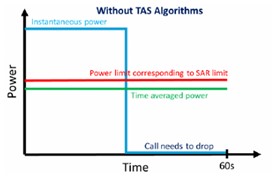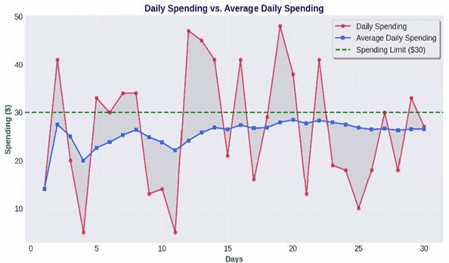TAS: an Evolution in Wireless Communication Performance
The Time-Averaged Specific Absorption Rate (TAS or T-SAR) algorithm is a breakthrough strategy in wireless communication technology that effectively enhances device transmission performance while ensuring compliance with regulations. Instead of merely reducing the peak power to comply with RF exposure regulations, TAS effectively maintains an average SAR value over a specified period of time, without sacrificing too much of the output power.

A modern-day smart wireless device is equipped with a multitude of radios employing 4G, 5G, Wi-Fi, and Bluetooth technologies, and each radio uses multiple antennas covering a wide variety of frequency bands to ensure the high user experience expectation of modern-day users. To meet these high user expectations, product design engineers have taken great care to maximize the transmit power of these radios to ensure that the Netflix movie or YouTube video you’re streaming on your smart wireless device won't be slowed or interrupted by a poor wireless signal.
Regulatory bodies of various countries and regions worldwide have set SAR criteria that all portable (i.e., used with 20cm of the human body) wireless devices must meet to protect users from exposure to excessive electromagnetic energies generated by these devices.
With a portable wireless device having multiple radios that transmit at maximum power for an extended period of time, however, the SAR level could easily exceed the regulatory limit, given the direct correlation between the SAR level and transmit output power level. To address this challenge, radio chipset manufacturers have developed what is called the time-averaged SAR (TAS) algorithm to intelligently manage transmit power across multiple radio antennas. This guarantees that the level of SAR will remain within the regulatory limit over the specified time period, while still allowing the device to maintain an optimal over-the-air transmission performance.
| Here is an illustration of a comparison between a wireless device employing a TAS algorithm and one that does not employ a TAS algorithm: | ||
|
The advantages of employing the TAS algorithm:
|
 |
 |
| As illustrated in the chart on the left, in the absence of the TAS algorithm, once the radio transmits at maximum output power for an extended period of time, the call must be terminated to comply with the SAR limit. As illustrated in the chart on the right, with the algorithm enabled, the radio would transmit at maximum output power for a specified period of time, but instead of dropping the call to comply with the SAR limit, the power is reduced to a level that allows the call to continue while still meeting the SAR limit. | ||
| Understanding TAS Using an Analogy | ||
 |
||
| Explaination | Using personal expenses as an example, assuming you have a monthly budget of $900
|
Applying this concept to TAS
|
SGS Taiwan boasts the most complete TAS verification scope out of all the labs in Taiwan:
|
Wireless Technology |
Chipset Provider |
Algorithm Name |
Version Differences |
Status |
|
WWAN |
Qualcomm |
Smart Transmit |
Approved |
|
|
Smart Transmit™ 2.0 |
Power backoff |
Approved |
||
|
Smart Transmit™ 3.0 |
Antenna group for EFS v19+ |
Approved |
||
|
Smart Transmit™ 4.0 |
Satellite Messaging (QSM) for EFS v20+ |
Approved |
||
|
Mediatek |
Time Average SAR (TA-SAR) |
Approved |
||
|
Time Average SAR (TA-SAR) 2.0 |
Antenna group, NTN, 3TX exposure switch |
Approved |
||
|
Time Average PD (TA-PD) |
Approved |
|||
|
Time Average PD (TA-PD) 2.0 |
ECI change, Multi_SPLSR FR1+FR2 switch |
Approved |
||
|
Intel |
Time Average SAR (TA-SAR) |
Approved |
||
|
WLAN |
Qualcomm |
FastConnect™ WIFI TAS |
Approved |
|
|
Mediatek |
Time-average Tech 1.0WL |
Approved |
||
|
Time-average Tech 2.0WL |
TER for Wi-Fi & BT simultaneous transmit |
Approved |
||
|
Realtek |
Time Average SAR Control 1.0 |
Approved |
||
|
Intel |
Time Average SAR |
Approved |
If you want to know more about IOT-NTN or certification requirements, please contact us:
📧 twwireless.MKT@sgs.com ☎ (02) 2299-3279 # 1530 / 1522 / 1567
